| peso dominicano (Spanish) | |
|---|---|
| ISO 4217 | |
| Code | DOP (numeric: 214) |
| Subunit | 0.01 |
| Unit | |
| Symbol | $ or RD$ |
| Denominations | |
| Subunit | |
| 1⁄100 | centavo |
| Banknotes | |
| Freq. used | 50, 100, 200, 500, 1000, 2000 pesos dominicanos |
| Coins | |
| Freq. used | 1, 5, 10, 25 pesos dominicanos |
| Demographics | |
| User(s) | |
| Issuance | |
| Central bank | Central Bank of the Dominican Republic |
| Website | www |
| Printer | Polish Security Printing Works |
| Website | www |
| Valuation | |
| Inflation | 1.4% |
| Source | The World Factbook, 2009 est. |
Peso dominicano (English: Dominican peso) has been the name of the currency of the Dominican Republic (Spanish: República Dominicana) since 2010. Its symbol is "$", with "RD$" used when distinction from other pesos (or dollars) is required; its ISO 4217 code is "DOP". Each peso is divided into 100 centavos ("cents"), for which the ¢ symbol is used. With exception of the United States dollar, it is the only currency that is legal tender in the Dominican Republic for all monetary transactions, whether public or private.
Before the 2010 constitution, peso oro (English: Gold peso) was the official name of the currency of the Dominican Republic.
History
The first Dominican peso was introduced with the country's independence from Haiti in 1844. It replaced the Haitian gourde at par and was divided into 8 reales. The Dominican Republic decimalized in 1877, subdividing the peso into 100 centavos. A second currency, the franco, was issued between 1891 and 1897 but did not replace the peso. However, in 1905, the peso was replaced by the U.S. dollar, at a rate of 5 pesos to the dollar. The peso oro was introduced in 1937 at par with the U.S. dollar, although the dollar continued to be used alongside the peso oro until 1947.
Coins
First peso, 1844–1905
Only one denomination of coin was issued by the Dominican Republic before decimalization. This was the 1⁄4 real, issued in 1844 in bronze and in both 1844 and 1848 in brass. Decimalization in 1877 brought about the introduction of three new coins, the 1, 2+1⁄2 and 5 centavos. 1⁄4 centavo coins were also issued between 1882 and 1888. In 1891 Dominican Republic entered in the Latin Monetary Union and changed its currency to the franco including coins of 5 and 10 centesimos struck in bronze and 50 centesimos, 1 and 5 francos struck in silver. After the franco was abandoned, silver coins were introduced in 1897 in denominations of 10 and 20 centavos, 1⁄2 and 1 peso. The designs of these coins were very similar to those of the franco.
Older Coins
 1877 One Centavo
1877 One Centavo 1891 One Franco
1891 One Franco 1891 Ten Centesimos
1891 Ten Centesimos 1877 2.5 Centavos
1877 2.5 Centavos 1877 Five Centavos
1877 Five Centavos.jpg.webp) 1891 25 Five Francos
1891 25 Five Francos 1848 Cuarto de Real
1848 Cuarto de Real
Peso Oro, from 1937
Coins were introduced in 1937 in denominations of 1, 5, 10, 25 centavos and 1⁄2 pesos with limited numbers of 1 peso coins first minted in 1939. All coins bore the national arms on the reverse while all except the 1 centavo bore a crowned allegorical Indian head on the obverse. The 1 centavo instead depicted a palm tree, the symbol of the ruling Dominican Party. The coins were all of identical weights, diameter, and composition to U.S. coins of the era. Two denominations appeared on these coins, one in "centavos" or "pesos" and another in "gramos" to represent a pre-decimal silver weight system formerly used in much of the region. A two coin set of 1955 commemorative coins were minted for the 25th anniversary of Rafael Trujillo's reign. These consisted of a gold 30 peso (33,000 minted) and a silver one peso, both showing him in profile. 50,000 of the silver one peso coins were produced in issued into circulation, but after Trujillo was assassinated in 1961 an estimated 32,550 were recalled and melted down. In 1963 the silver content in the 10, 25, 50, and 1 peso coins was reduced from 0.900 pure to 0.650 pure. The 1963 issue also distinctively commemorated the centennial of the republic and the crowned Indian head was added to the 1 centavo, replacing the palm.
After 1963 the Peso Oro became a fiat currency and base metals replaced silver in the higher denominations, with the 10, and 25 centavos and 1⁄2 pesos reintroduced in copper-nickel in 1967. 1 peso coins were struck as only commemorative in small numbers. In 1976 a new coin series was introduced featuring Juan Pablo Duarte, and in 1983 another series was released featuring various other figures important to Dominican history, including the Mirabal sisters and formally dropping the outdated "gramos" denomination reference. In 1989, the content of the coins was changed from copper-nickel to nickel-plated steel. In 1991, eleven sided circulating non commemorative 1 peso coins were reintroduced in copper-zinc, followed by bimetal 5 pesos in 1997. For the latter coin the first year of issue was a circulating commemorative for the 50th anniversary of the national bank.[1] Both a bimetal 10 pesos and a copper-nickel 25 pesos were introduced in 2005. Due to inflation, any coins below 1 peso are now rarely found.
RECENT COINS
- 1 Peso
- 5 Pesos
- 10 pesos
- 25 Pesos
Banknotes
.jpg.webp)
First peso, 1848–1905
Paper money made up the bulk of circulating currency for the first peso. Provisional issues of 40 and 80 pesos were produced in 1848, followed by regular government notes for 1, 2 and 5 pesos in 1849, and 10 and 50 peso notes in 1858. The Comisión de Hacienda issued 50 and 200 pesos in 1865, whilst the Junta de Crédito introduced notes for 10 and 20 centavos that year, followed by 5 and 40 centavos in 1866 and 1, 2, 5 and 10 pesos in 1867. In 1862, the Spanish issued notes for 1⁄2, 2, 5, 15 and 25 pesos in the name of the Intendencia de Santo Domingo. The last government notes were 1 peso notes issued in 1870.
Two private banks issued paper money. The Banco Nacional de Santo Domingo issued notes between 1869 and 1889 in denominations of 25 and 50 centavos, 1, 2, 5, 10, 20, 25 and 100 pesos. The Banco de la Compañía de Crédito de Puerto Plata issued notes from the 1880s until 1899 in denominations of 25 and 50 centavos, 1, 2, 5, 10 and 50 pesos. Note that the Banco Nacional de Santo Domingo also issued notes in 1912 denominated in dollars (called pesos in the Spanish text).
Peso Oro, 1947-2011
When the peso oro was first introduced as a local coinage in 1937, no paper money was made and US notes continued to circulate as the U.S. dollar was officially the national currency. Only in 1947 were the first peso oro notes issued by the Central Bank in denominations of 1, 5, 10, 20, 50, 500, and 1000 oros, though the latter two denominations were rarely used. These notes were printed by the American Bank Note Company, a private printing and engraving firm. Though US notes were always acceptable in exchange, they were gradually withdrawn from circulation. In 1961, low value notes were issued in denominations of 10, 25 and 50 centavos to help compensate for the value of silver in coins surpassing face value and the resulting coin shortages. Following the demise of Trujillo all banknotes afterwards dropped references to the capital city Ciudad Trujillo which had reverted to its old name, Santo Domingo.
Banknotes currently in circulation are 50, 100, 200, 500, 1000 and 2000 pesos oros. The 10 and 20 peso denomination bills have been replaced with 10 and 25 peso coins respectively in 2005. In 2010, a new 20 pesos oro polymer banknote was released. Limited editions of the 500 and 2000 peso oro notes were issued for the 1992 500th anniversary of the discovery of the Americas and year 2000 millennial celebrations, respectively, but as of 2005 not many of these remain in circulation. A 5000 pesos note has been considered before but not made.
All current banknotes carry the phrase "Este billete tiene fuerza libertoria para el pago de todas las obligaciónes públicas o privadas". Literally translated, (Spanish: This bill has the liberatory strength to be used as payment for all public or private obligations).
2010
On July 1, 2010, the Central Bank of Dominican Republic issued a 20-peso oro banknote that is similar to the previous paper issue, but is now printed on a polymer substrate.[2]
2011
In 2011, the Central Bank of Dominican Republic announced that all banknotes dated 2011 and later will be denominated in "Pesos Dominicanos" instead of "Pesos Oro". This decision was made in response to a mandate of the Constitution of the Dominican Republic of January 26, 2010.[3][4][5][6][7]
2014
On October 1, 2014, the Central Bank of Dominican Republic planned to issue a new family of notes with new designs and new security features.[8][9][10]
Notes in circulation
| Banknotes | Value | Color | Description | |||
|---|---|---|---|---|---|---|
| Front | Reverse | Front | Reverse | |||
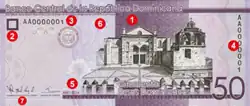 |
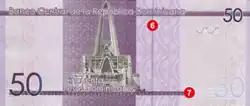 |
50 Pesos | Purple | Basilica Cathedral of Santa María la Menor | Basilica of Our Lady of Altagracia | |
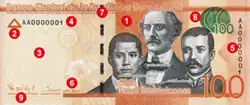 |
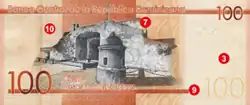 |
100 Pesos | Orange | Francisco del Rosario Sánchez, Juan Pablo Duarte and Matías Ramón Mella | The Count's Gate | |
 |
 |
200 Pesos | Pink | Mirabal Sisters | Monument to the Mirabal Sisters | |
 |
 |
500 Pesos | Green | Salomé Ureña and Pedro Henríquez Ureña | Central Bank of the Dominican Republic | |
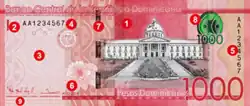 |
 |
1,000 Pesos | Red | National Palace | Columbus Alcazar | |
 |
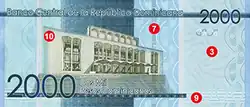 |
2,000 Pesos | Blue | Emilio Prud'Homme and José Rufino Reyes Siancas (composers of the national anthem of the Dominican Republic) | National Theater | |
Other bills
| Image | Value | Description | ||
|---|---|---|---|---|
| Front | Reverse | Front | Reverse | |
| 10 Pesos Oro | Juan Pablo Duarte | Ingenio Rio Haina Sugar cane factory | ||
| 10 Pesos Oro | Juan Pablo Duarte | Ingenio Rio Haina Sugar cane factory | ||
| 20 Pesos Oro | Francisco del Rosario Sánchez | Valdesia Dam | ||
| 50 Pesos Oro | Basilica de Higuey | |||
| 100 Pesos Oro | Gregorio Luperón | Panteón Nacional | ||
| 1000 Pesos Oro | Gregorio Luperón | Panteón Nacional | ||
| 2000 Pesos Oro | Gregorio Luperón | Panteón Nacional | ||
Relation with the U.S. dollar
The United States dollar is used as a reserve currency by the Central Bank of the Dominican Republic. Also, when agreed by both parties, both U.S. dollars and the euro can be used in private transactions (this applies mostly in tourism-related activities). This was most true during the drastic inflationary period of 2003–2004. Nowadays the U.S. dollar is widely accepted and tourists visiting the Dominican Republic can use it as a second currency.
Historical exchange rates
Historically, since the first monetary emission in 1948, the peso was worth about the same as a United States dollar.
The exchange rate for U.S. dollar vs. Dominican peso over the last few decades is as follows:
- 1984 US$1 to RD$1.45
- 1993 US$1 to RD$5
- 1998 US$1 to RD$8
- 2002 US$1 to RD$20
- 2003 US$1 to RD$37.5
- 2004 US$1 to RD$46.7
- 2006 US$1 to RD$32
- 2007 US$1 to RD$35.29
- 2008 US$1 to RD$34.93
- 2009 US$1 to RD$36
- 2012 US$1 to RD$40.5
- 2013 US$1 to RD$40.4
- 2016 US$1 to RD$45
In 2004 the peso dramatically plummeted; a single US dollar was worth almost RD$60. In August 2020, RD$59 mark was temporarily crossed again.
As of February 8, 2023, US$1 buys around 56.30 pesos.
| Current DOP exchange rates | |
|---|---|
| From Google Finance: | AUD CAD CHF CNY EUR GBP HKD JPY USD JPY USD |
| From Yahoo! Finance: | AUD CAD CHF CNY EUR GBP HKD JPY USD JPY USD |
| From XE.com: | AUD CAD CHF CNY EUR GBP HKD JPY USD JPY USD |
| From OANDA: | AUD CAD CHF CNY EUR GBP HKD JPY USD JPY USD |
See also
References
- ↑ 5 Pesos Central Bank
- ↑ Dominican Republic new 20-peso oro polymer note confirmed BanknoteNews.com. Retrieved 2011-10-16.
- ↑ Dominican Republic announces features of new 2011-dated banknotes BanknoteNews.com. Retrieved 2011-10-16.
- ↑ Dominican Republic new 50- and 100-peso dominicano notes confirmed BanknoteNews.com. December 24, 2011. Retrieved on 2013-06-19.
- ↑ Dominican Republic new 500-peso dominicano note confirmed BanknoteNews.com. January 31, 2012. Retrieved on 2013-06-19.
- ↑ Dominican Republic new 1,000-peso dominicano note confirmed BanknoteNews.com. December 14, 2012. Retrieved on 2013-06-19.
- ↑ Dominican Republic new 2,000-pesos dominicanos note confirmed BanknoteNews.com. March 22, 2013. Retrieved on 2013-06-19.
- ↑ Poster for the new family of banknotes by the Banco Central de la República Dominicana Banco Central de la República Dominicana (Central Bank of the Dominican Republic) (www.bancentral.gov.do). Retrieved on 2014-09-16.
- ↑ Dominican Republic new 50, 100, and 500-peso dominicano notes confirmed BanknoteNews.com. October 13, 2014. Retrieved on 2014-10-13.
- ↑ Dominican Republic new 2,000-peso dominicano note confirmed BanknoteNews.com. December 16, 2014. Retrieved on 2014-12-22.
- Krause, Chester L.; Clifford Mishler (1991). Standard Catalog of World Coins: 1801–1991 (18th ed.). Krause Publications. ISBN 0873411501.
- Pick, Albert (1994). Standard Catalog of World Paper Money: General Issues. Colin R. Bruce II and Neil Shafer (editors) (7th ed.). Krause Publications. ISBN 0-87341-207-9.
- Pick, Albert (1990). Standard Catalog of World Paper Money: Specialized Issues. Colin R. Bruce II and Neil Shafer (editors) (6th ed.). Krause Publications. ISBN 0-87341-149-8.
- Rudman, Isaac and Estrella, Miguel: Monedas de la República Dominicana. Sociedad Numismatica Dominicana, Santo Domingo, 1979
